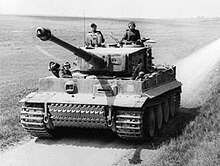Wikijunior:World War II/Tanks
| This Wikijunior article is a stub. You can help Wikijunior by expanding it. |
Tanks
[edit | edit source]Tanks are large, heavily armoured vehicles used for fighting. Tanks move on 'treads' which allow them to travel on almost any surface (except for water) and most tanks have a large cannon which are used to attack other vehicles, buildings and large groups of men. Most tanks also have a smaller machine gun for fighting against troops.
Tanks were first used by the British in World War I by the British, then later in the war by the Germans, French, and the Americans. However, tanks didn't play a big role in combat until World War II.
Tanks were able to cross trench lines quickly, without taking much damage, as usually they were bulletproof. This was very useful as it allowed armies to move forward much more quickly. During the war however anti-tank traps were put in place to make tanks less effective.
Use in Combat
[edit | edit source]During the beginning of the war, tanks would accompany troops, being used solely as weapons to aid the ground troops.
Towards the end of the war, many tanks were being fitted with radios, allowing them to communicate with one-another and be able to go off on their own or in groups, without the ground troops to guide them. This allowed tanks to move much faster for they were no longer forced to move at the same speed as the walking troops while at war.
Tanks were adapted to perform a variety of different jobs, from clearing minefields to fortifying/destroying roads and bridges.
World War II firmly cemented the tank in the military, proving that troops alone could no longer win wars.
Nations
[edit | edit source]Most of the large nations involved in the war had tanks. The Germans used several different types of panzers (the German name for a tank) including the Tiger and Panther. The Soviets generally used T-34s. The British, American, French and Polish forces, along with other nations, also used tanks in combat.
Tanks Used in the War
[edit | edit source]IS-2
[edit | edit source]IS-3
[edit | edit source]M3 Lee/Grant
[edit | edit source]M4 Sherman
[edit | edit source]Churchill
[edit | edit source]Mk VI Crusader
[edit | edit source]M3 Stuart
[edit | edit source]Panzer I
[edit | edit source]Panzer I (also known as Panzerkampfwagen I) was developed as a training tank in the 1930s by Germany but was used as the main tank for Germany's army in the early stages of World War 2. The Panzer I was only equipped with two machine guns so couldn't fight other tanks.

Panzer II
[edit | edit source]Panzer III
[edit | edit source]Panzer III (also known as Panzerkampfwagen III) was developed in the 1930s by Germany. Production of the Panzer III ended in 1943. Until 1942, the Panzer III was the first German tank armed with a weapon that could penetrate the armor of the main British and Soviet tanks.

Panzer IV
[edit | edit source]The Panzer IV (also known as the Panzerkampfwagen IV) was a tank developed by Germany in the late 1930s. Having a 75 mm Lwk gun, it could penetrate the best soviet tanks fairly easily.

Panther (Panzer V)
[edit | edit source]The Panther was the best known German tank in the war. It was first produced in 1942. Classified medium tank by the Germans, its weight allowed it to be a heavy tank. Had 76 mm gun. Even though smaller gun it had more pressure in the barrel therefore more speed then tiger. It had constant breakdowns, but later models resolved this issue partway. Angled armor made this tank impenetrable only through turret ring. Later models, like Panther G, had a chin mantlet which resolved this issue.

Tiger I (Panzer VI)
[edit | edit source]
Tiger I is the common name of a German heavy tank which was developed in 1942. The official German designation was Panzerkampfwagen Tiger Ausf. E. It was very powerful and could take a hit. Looking on paper, the amount of armor this tank has (mostly non sloped) is very good. When its angled, however, this tank was nearly impenetrable.
Tiger II (KonigsTiger)
[edit | edit source]
The Tiger II was a beast of a tank, with upgraded 88mm gun, also with immense amount of armor. Very slow and had breakdowns. No allied tank during the war could destroy this machine in a frontal engagement.The only time a tank of this sort was taken from combat was when it was captured or tracked.
Maus
[edit | edit source]
The Maus (meaning mouse in German) was quite the opposite. This vehicle was massive, and was designed to be a mobile bunker. Two prototypes were built in the later part of the war, one was fitted with a turret and the other was just the chassis. This vehicle never saw combat other than being shot at by the Germans. A completed tank would have weighed 188 tonnes.
KV-1
[edit | edit source]KV-2
[edit | edit source]Its iconic 152 mm gun and turret allowed it to completely destroy almost any tank with a single shot.
T-34
[edit | edit source]The T-34 was a Soviet tank produced from 1940 to 1958 at the KhPZ factory in Kharkov. Sloped armor helped its survivability but later German tanks outclassed it by far.

